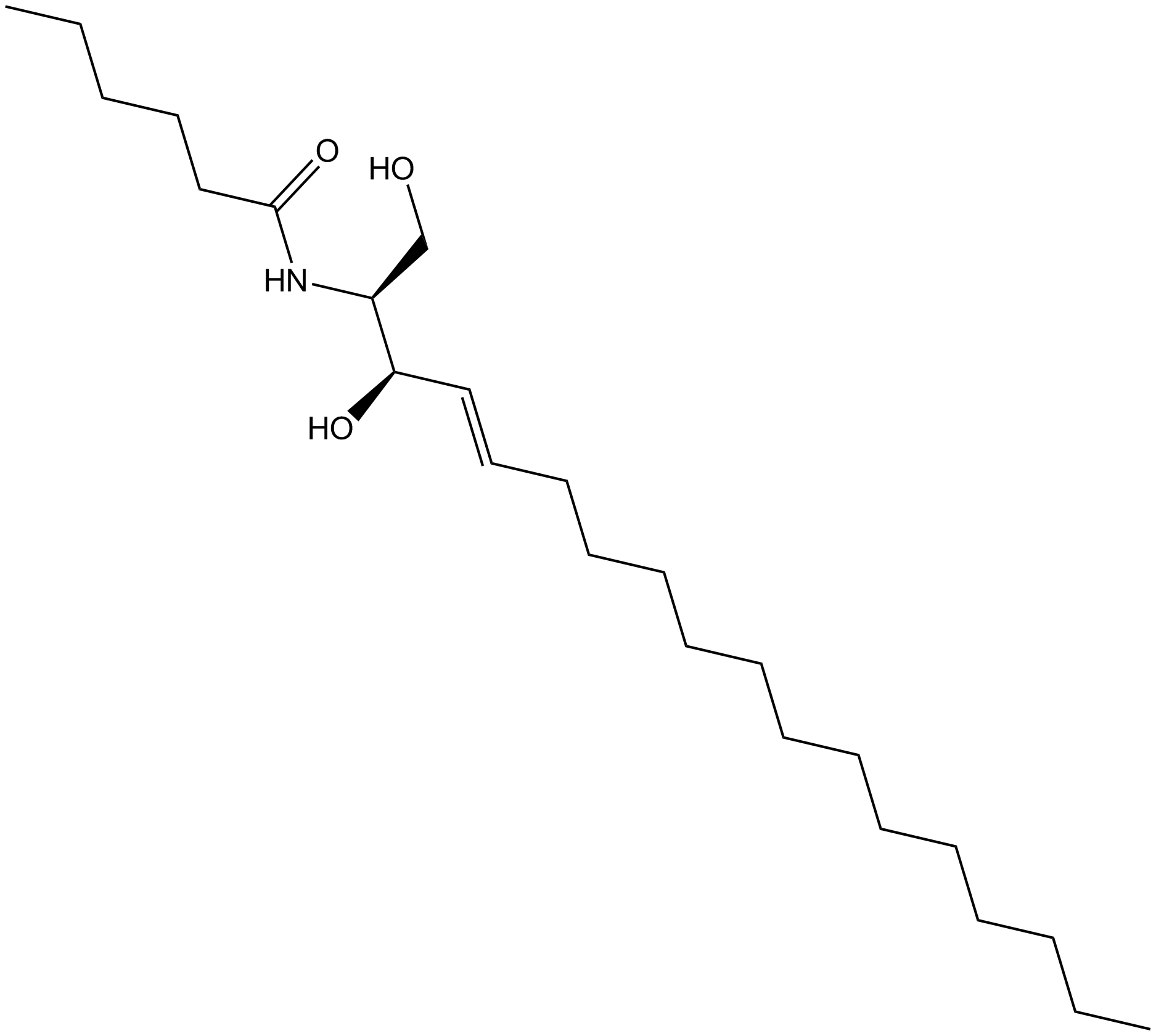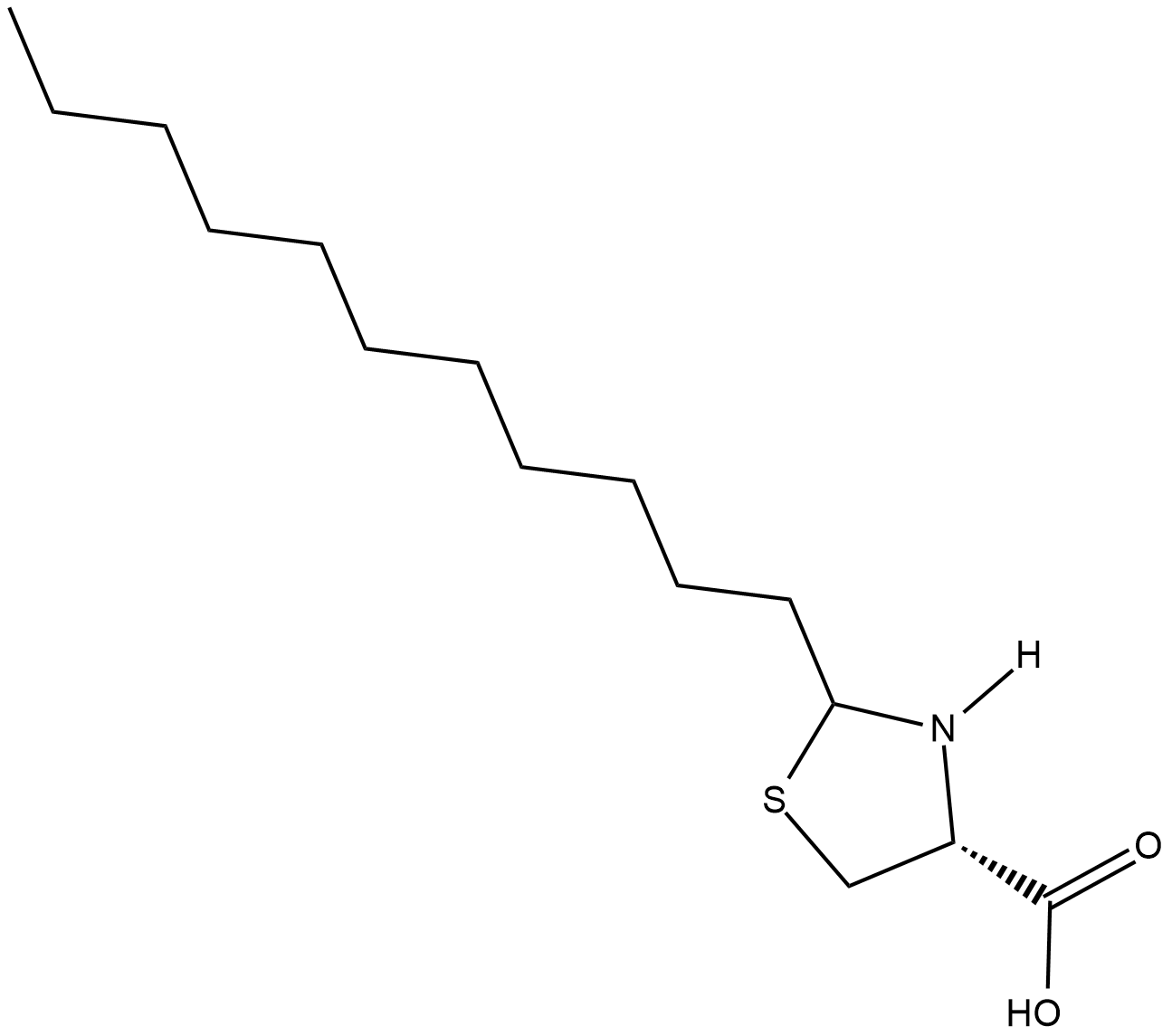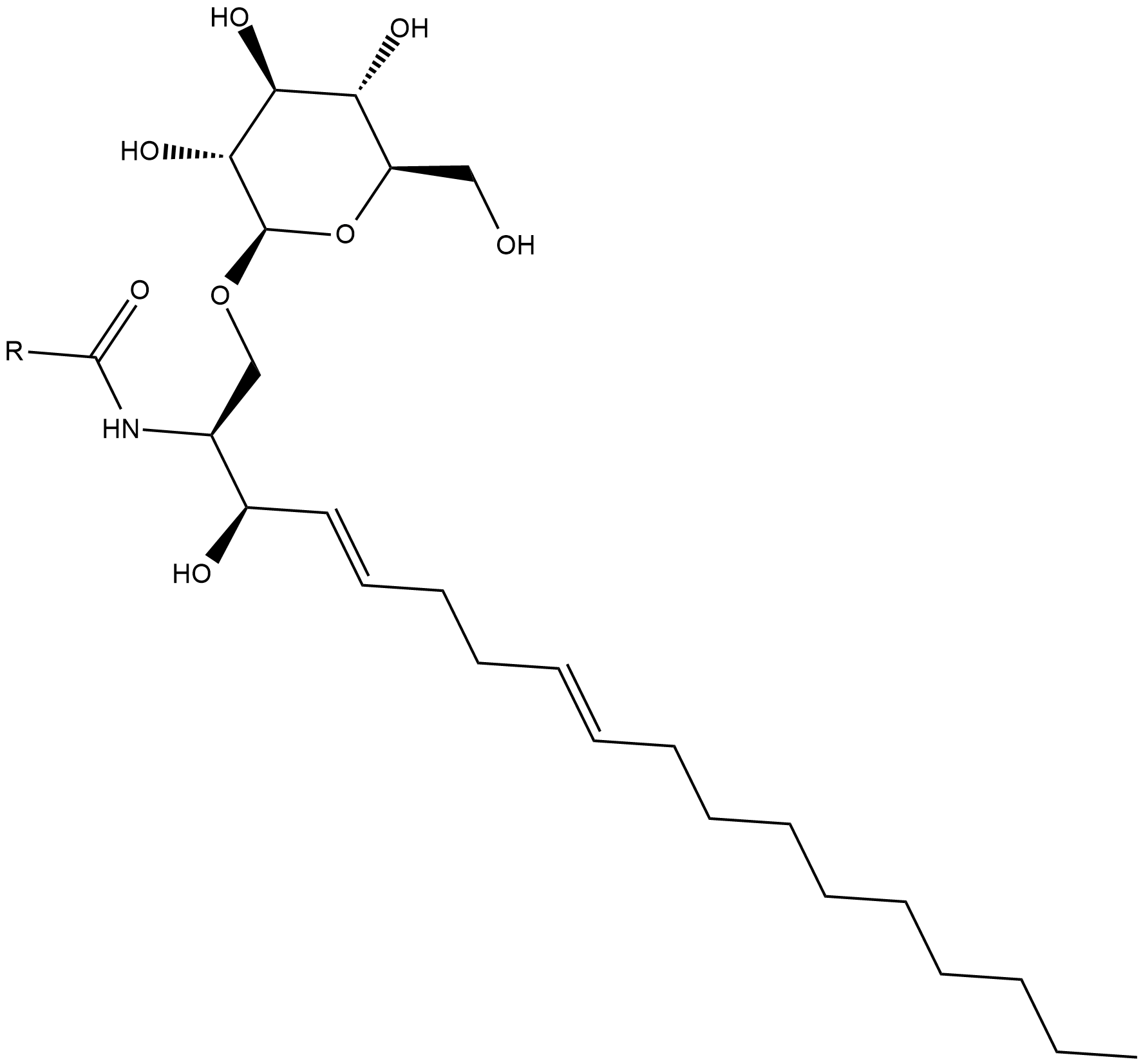Sphingolipids
Products for Sphingolipids
- Cat.No. Product Name Information
-
GC43071
C22 Sphingomyelin (d18:1/22:0)
C22 Sphingomyelin is a naturally occurring form of sphingomyelin.

-
GC43072
C23 Globotriaosylceramide (d18:1/23:0)
C23 Globotriaosylceramide is a sphingolipid that has been used as a standard for the quantification of globotriaosylceramides in human fibroblasts by HPLC/APCI-MS.

-
GC45836
C24 (2'(R)-hydroxy) dihydro Ceramide (d18:0/24:0)
A hydroxylated dihydro ceramide

-
GC45834
C24 (2'(R)-hydroxy) Phytoceramide (t18:0/24:0)
A bioactive sphingolipid

-
GC45835
C24 (2'(S)-hydroxy) Phytoceramide (t18:0/24:0)
A sphingolipid

-
GC46109
C24 1-Deoxyceramide (m18:1/24:0)
A very long-chain atypical ceramide

-
GC43073
C24 3'-sulfo Galactosylceramide (d18:1/24:0)
C24 3'-sulfo Galactosylceramide is an endogenous sulfated glycolipid, which are also known as sulfatides.

-
GC43074
C24 Ceramide (d18:1/24:0)
Production of ceramide occurs upon hydrolysis of sphingomyelin by a specific isoform of PLC, appropriately named sphingomyelinase.

-
GC47005
C24 Ceramide-d7 (d18:1-d7/24:0)
An internal standard for the quantification of lignoceric ceramide

-
GC46110
C24 dihydro 1-Deoxyceramide (m18:0/24:0)
A very long-chain atypical ceramide

-
GC43075
C24 dihydro Ceramide (d18:0/24:0)
C24 dihydro Ceramide is a sphingolipid that has been found in the stratum corneum of human skin.

-
GC43076
C24 Phytosphingosine (t18:0/24:0)
C24 Phytosphingosine (t18:0/24:0) is a phytoceramide, which is a family of sphingolipids found in the intestine, kidney, and extracellular spaces of the stratum corneum of the mammalian epidermis.

-
GC46111
C24:1 1-Deoxyceramide (m18:1/24:1(15Z))
A very long-chain atypical ceramide

-
GC43077
C24:1 3'-sulfo Galactosylceramide (d18:1/24:1(15Z))
C24:1 3'-sulfo Galactosylceramide is a member of the sulfatide class of glycolipids.

-
GC43078
C24:1 Ceramide (d18:1/24:1(15Z))
Production of ceramide occurs upon hydrolysis of sphingomyelin by a specific isoform of PLC, appropriately named sphingomyelinase.

-
GC47006
C24:1 Ceramide-d7 (d18:1-d7/24:1(15Z))
An internal standard for the quantification of nervonic ceramide

-
GC45952
C24:1 dihydro 1-Deoxyceramide (m18:0/24:1)
A very long-chain atypical ceramide

-
GC47007
C26 Sphingomyelin (d18:1/26:0)
A sphingolipid

-
GC47009
C26:1 Sphingomyelin (d18:1/26:1(17Z))
A naturally occurring sphingolipid

-
GC43080
C30 Ceramide (d18:1/30:0)
C30 Ceramide is a naturally occurring ceramide that has been found in the stratum corneum of human and nude mouse skin.

-
GC43081
C30(ω-hydroxy) Ceramide (d18:1/30:0)
C30(ω-hydroxy) Ceramide is a bioactive sphingolipid found in the stratum corneum layer of mammalian epidermis.

-
GC43082
C32 Ceramide (d18:1/32:0)
C32 Ceramide is a naturally occurring ceramide that has been found in the stratum corneum of human and nude mouse skin.

-
GC43084
C4 Ceramide (d18:1/4:0)
C4 Ceramide is a bioactive sphingolipid and cell-permeable analog of naturally occurring ceramides.

-
GC43086
C6 Biotin Ceramide (d18:1/6:0)
C6 Ceramide-biotin is an affinity probe that allows C2 ceramide (d18:1/2:0) to be detected or immobilized through interaction with the biotin ligand.

-
GC45839
C6 Biotin dihydro Ceramide (d18:0/6:0)
An affinity probe for C6 dihydro ceramide binding partners

-
GC49013
C6 Biotin Ganglioside GD3 (d18:1/6:0) (ammonium salt)
An affinity probe for ganglioside GD3 binding partners

-
GC43089
C6 Biotin Glucosylceramide (d18:1/6:0)
C6 Biotin glucosylceramide is an affinity probe that allows C6 glucosylceramide to be detected or immobilized through interaction with the biotin ligand.

-
GC45840
C6 Biotin Phytoceramide (t18:0/6:0)
An affinity probe for C6 phytoceramide binding partners

-
GC11079
C6 Ceramide (d18:1/6:0)
C6-ceramide, a ceramide pathway activator, shows activity against a variety of cancer cell lines. C6-ceramide can be used as an adjuvant for chemotherapeutic agents, to enhance anti-tumor effects.

-
GC43091
C6 Ceramide (d18:1/6:0) Alkyne
C6 Ceramide alkyne is an ω-alkyne derivative of C6 ceramide.

-
GC40688
C6 D-threo Ceramide (d18:1/6:0)
C6 D-threo Ceramide is a bioactive sphingolipid and cell-permeable analog of naturally occurring ceramides., C6 D-threo Ceramide is cytotoxic to U937 cells in vitro (IC50 = 18 μM).

-
GC43092
C6 dihydro Ceramide (d18:0/6:0)
C6 dihydro Ceramide is a metabolically inactive analog of C6 ceramide that has been used as a negative control in experiments investigating the biological activity of C6 ceramide.

-
GC47015
C6 Glucosylceramide (d18:2/6:0)
A glucosylated form of C6 ceramide

-
GC40689
C6 L-erythro Ceramide (d18:1/6:0)
C6 L-erythro Ceramide is a bioactive sphingolipid and cell-permeable analog of naturally occurring ceramides.

-
GC40690
C6 L-threo Ceramide (d18:1/6:0)
C6 L-threo Ceramide (d18:1/6:0) is a bioactive sphingolipid and cell-permeable analog of naturally occurring ceramides.

-
GC43096
C6 NBD Ceramide (d18:1/6:0)
C6 NBD Ceramide (d18:1/6:0) is a Golgi apparatus fluorescent probe with cell membrane permeability.

-
GC43097
C6 NBD dihydro Ceramide (d18:0/6:0)
C6 NBD dihydro Ceramide (d18:0/6:0) is a sphinganine analog and can be used as fluorescent dye for labeling fatty acid.

-
GC43098
C6 NBD Galactosylceramide (d18:1/6:0)
C6 NBD galactosylceramide is an active derivative of galactosylceramide that is tagged with fluorescent C6 nitrobenzoxadiazole (C6 NBD).

-
GC43099
C6 NBD Glucosylceramide (d18:1/6:0)
C6 NBD Glucosylceramide (d18:1/6:0) is a glucosylceramide fluorescent derivative (Ex=466 nm, Em=535 nm).

-
GC43101
C6 NBD L-threo Ceramide (d18:1/6:0)
C6 NBD L-threo Ceramide (d18:1/6:0) is a membrane-permeable ceramides.

-
GC43100
C6 NBD Lactosylceramide (d18:1/6:0)
C6 NBD Lactosylceramide (d18:1/6:0) is a derivative of lactosylceramides, and can be used in lactosylceramide synthase assay as a fluorescent acceptor substrate. C6 NBD Lactosylceramide (d18:1/6:0) can also be used in cancer research.

-
GC40774
C6 NBD Phytoceramide (t18:0/6:0)
C6 NBD phytoceramide is a biologically active derivative of C6 phytoceramide that is tagged with a fluorescent C6 nitrobenzoxadiazole group.

-
GC43103
C6 NBD Sphingomyelin (d18:1/6:0)
C6 NBD Sphingomyelin (d18:1/6:0) is a fluorescent short-chain analogue of Sphingomyelin.

-
GC43104
C6 Phytoceramide (t18:0/6:0)
C6 Phytoceramide is a cell-permeable analog of phytoceramide.

-
GC45616
C6 Urea Ceramide
An inhibitor of neutral ceramidase

-
GC43106
C8 Ceramide-1-phosphate (d18:1/8:0)
C8 ceramide-1-phosphate is a short-chain analog of the naturally occurring ceramide-1-phosphate.

-
GC43107
C8 Ceramine (d18:1/8:0)
C8 Ceramine is an analog of C8 ceramide in which the carbonyl group of the ceramide is replaced by a methylene group.

-
GC43109
C8 D-threo Ceramide (d18:1/8:0)
C8 D-threo Ceramide is a bioactive sphingolipid and cell-permeable analog of naturally occurring ceramides.

-
GC43108
C8 dihydro Ceramide (d18:0/8:0)
C8 dihydro Ceramide (d18:0/8:0) is a negative control of C8 Ceramide. C8-Ceramide (N-Octanoyl-D-erythro-sphingosine) is a cell-permeable analog of naturally occurring ceramides. C8-Ceramide has anti-proliferation properties and acts as a potent chemotherapeutic agent. C8-Ceramide stimulates dendritic cells to promote T cell responses upon virus infections. C8-Ceramide induces slight activation of protein kinase (PKC) in vitro.

-
GC43110
C8 Galactosylceramide (d18:1/8:0)
C8 Galactosylceramide is a synthetic C8 short-chain derivative of known membrane microdomain-forming sphingolipids.

-
GC43111
C8 L-threo Ceramide (d18:1/8:0)
C8 L-threo Ceramide is a bioactive sphingolipid and cell-permeable analog of naturally occurring ceramides.

-
GC43112
C8 Phytoceramide (t18:0/8:0)
C8 Phytoceramide is a cell-permeable analog of phytosphingosine.

-
GC18757
CAY10444
A family of related G-protein coupled receptors that bind sphingosine-1 phosphate (S1P) as a high-affinity ligand have recently been cloned.

-
GC40757
CAY10734
An S1P1 receptor agonist

-
GC41494
CAY10739
CAY10739 is a selective S1PR1 inhibitor, with a pIC50 of 7.6, with >40- and >80-fold selectivity, over the other S1PR isoforms S1PR2/3/4.

-
GC52489
Ceramide (hydroxy) (bovine spinal cord)
A sphingolipid

-
GC52485
Ceramide (non-hydroxy) (bovine spinal cord)
A sphingolipid

-
GC52486
Ceramide Phosphoethanolamine (bovine)
A sphingolipid

-
GC43229
Ceramide Phosphoethanolamines (bovine)
Ceramide phosphoethanolamine (CPE) is an analog of sphingomyelin that contains ethanolamine rather than choline as the head group.

-
GC47073
Ceramides (hydroxy)
A mixture of hydroxy fatty acid-containing ceramides

-
GC43230
Ceramides (non-hydroxy)
Ceramides are generated from sphingomyelin through activation of sphingomyelinases or through the de novo synthesis pathway, which requires the coordinated action of serine palmitoyl transferase and ceramide synthase.

-
GC47074
Cerebroside C
A fungal metabolite

-
GC45877
CYM 5478
An S1P2 agonist

-
GC40296
D-erythro-MAPP
D-erythro-MAPP is a derivative of ceramide and an inhibitor of alkaline ceramidase (Ki = 2-13 μM; IC50 = 1-5 μM).

-
GC47189
D-erythro/L-threo Lysosphingomyelin (d18:1)
A mixture of bioactive sphingolipids

-
GC40792
D-threo Sphinganine (d18:0)
D-threo Sphinganine (d18:0) is a synthetic bioactive sphingolipid and stereoisomer of sphinganine (d18:0) and L-erythro sphinganine (d18:0).

-
GC47276
D-threo-PPMP (hydrochloride)
A GlyCer synthetase inhibitor

-
GC49672
DL-erythro-PDMP (hydrochloride)
A mixture of PDMP isomers

-
GC43488
DL-erythro/threo Sphinganine (d16:0)
DL-erythro/threo Sphinganine (d16:0) is a sphingolipid that is decreased in rats following long-term, low-dose administration of dimethoate and is used as a biomarker for dimethoate exposure.

-
GC43494
DL-threo-PDMP (hydrochloride)
DL-threo PDMP is a mixture of ceramide analogs that contains two of the four possible stereoisomers of PDMP : D-threo (1R,2R) and L-threo (1S,2S) PDMP.

-
GC47286
Eliglustat-d15 (tartrate)
An internal standard for the quantification of eliglustat

-
GC43615
EOS (d18:1/30:0/18:2)
EOS is a ceramide found in the outer layer of the epidermis in mammals.

-
GC43616
EOS (d18:1/32:1/18:2)
EOS is a ceramide found in the outer layer of the epidermis in mammals.

-
GC40887
FTY720 (R)-Phosphate
FTY720 is a novel immune modulator that prolongs allograft transplant survival in numerous models by inhibiting lymphocyte emigration from lymphoid organs.

-
GC52483
Fucosylated Ganglioside GM1 (porcine) (ammonium salt)
A sphingolipid

-
GC52288
Fumonisin B1-13C34
An internal standard for the quantification of fumonisin B1

-
GC18469
Galactosylcerebrosides (bovine)
Galactosylcerebrosides are glycosphingolipids that contain a galactose attached to a ceramide acylated with hydroxy and non-hydroxy fatty acids.

-
GC43721
Galactosylcerebrosides (hydroxy)
Galactosylcerebrosides are glycosphingolipids that contain a galactose attached to a ceramide acylated with a hydroxy or non-hydroxy fatty acid.

-
GC43722
Galactosylcerebrosides (non-hydroxy)
Galactosylcerebrosides are glycosphingolipids that contain a galactose attached to a ceramide acylated with a hydroxy or non-hydroxy fatty acid.

-
GC43723
Galactosylsphingosine (d18:1)
Galactosylsphingosine (d18:1) (Galactosylsphingosine), a substrate of the galactocerebrosidase (GALC) enzyme, is a potential biomarker for Krabbe disease.

-
GC43727
Ganglioside GD1a mixture (sodium salt)
Ganglioside GD1a is a sialic acid-containing glycosphingolipid found in brain, erythrocytes, bone marrow, testis, spleen, and liver.

-
GC43728
Ganglioside GD1b Mixture (sodium salt)
Ganglioside GD1b is an acidic glycosphingolipid that contains two sialic acid residues linked to an inner galactose unit.

-
GC49490
Ganglioside GD2 Mixture (bovine buttermilk) (ammonium salt)
A semi-synthetic mixture of ganglioside GD2

-
GC43729
Ganglioside GD3 Mixture (sodium salt)
Ganglioside GD3 is synthesized by the addition of two sialic acid residues to lactosylceramide and can serve as a precursor to the formation of more complex gangliosides by the action of glycosyl- and sialyltransferases.

-
GC43730
Ganglioside GM1 Asialo Mixture
Ganglioside GM1 asialo is a component of cellular lipid rafts and can be formed by the cleavage of the sialic acid residue from ganglioside GM1 by neuraminidase.

-
GC47392
Ganglioside GM1 Mixture (ovine) (ammonium salt)
A mixture of ganglioside GM1

-
GC43731
Ganglioside GM2 Asialo Mixture
Ganglioside GM2 asialo (asialo- GM2) is a glycosphingolipid containing three monosaccharide residues and a fatty acid of variable chain length but lacking the sialic acid residue present on ganglioside M2.

-
GC40016
Ganglioside GM2 Mixture (sodium salt)
Ganglioside GM2 is a glycosphingolipid component of cellular membranes, primarily the plasma membrane.

-
GC43732
Ganglioside GM3 Mixture (sodium salt)
Ganglioside GM3 is a monosialoganglioside that demonstrates antiproliferative and proapoptotic effects in tumor cells by modulating cell adhesion, proliferation, and differentiation.

-
GC52487
Ganglioside GM4 (chicken egg) (ammonium salt)
A sphingolipid

-
GC43734
Ganglioside GQ1b Mixture (sodium salt)
Ganglioside GQ1b is a tetrasialoganglioside that contains two sialic acid residues linked to an inner galactose unit.

-
GC52505
Ganglioside GT1b (bovine) (sodium salt)
A sphingolipid

-
GC43735
Ganglioside GT1b Mixture (sodium salt)
Ganglioside GT1b is a trisialoganglioside that is characterized by having two sialic residues linked to the inner galactose unit.

-
GC43757
Globotetraosylceramides (porcine RBC)
Globotetraosylceramides are bioactive neutral glycosphingolipids.

-
GC52492
Globotriaosylceramide (hydroxy) (porcine RBC)
A sphingolipid

-
GC52491
Globotriaosylceramide (non-hydroxy) (porcine RBC)
A sphingolipid

-
GC43758
Globotriaosylceramides (hydroxy) (porcine)
Globotriaosycleramides are glycosphingolipids found in mammalian cell membranes that are synthesized from lactosylceramides.

-
GC43760
Globotriaosylceramides (porcine)
Globotriaosycleramides are glycosphingolipids found in mammalian cell membranes that are synthesized from lactosylceramides.

-
GC18387
Glucocerebrosides
Glucocerebrosides are formed by the tethering of glucose to a ceramide by glucosylceramide synthase.

-
GC43768
Glucocerebrosides (Gaucher's spleen)
Glucocerebrosides are formed by the tethering of glucose to a ceramide by glucosylceramide synthase.



